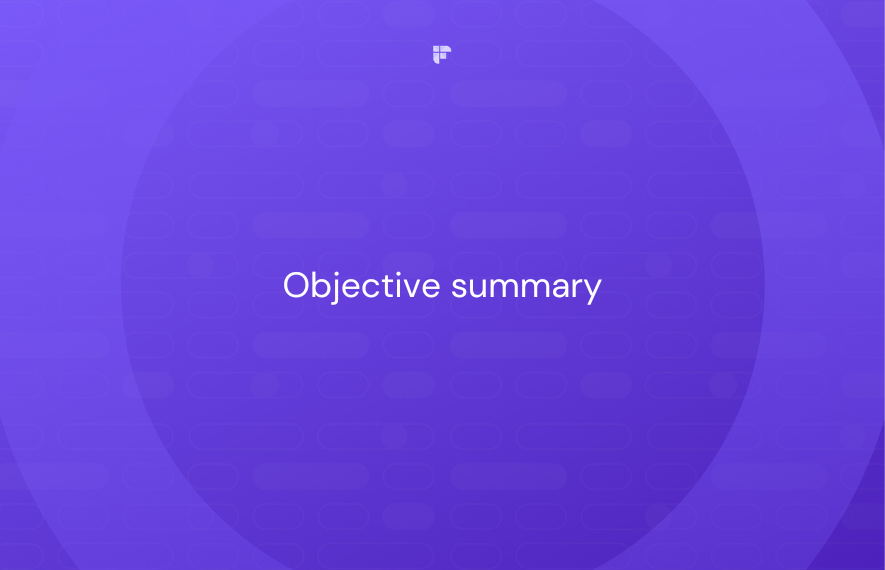Knowing how to write an objective summary of lengthy, complex documents is invaluable for workplace efficiency, academic success, and personal comprehension.
But how do you know your summary is truly "objective"?
This in-depth guide will teach you what an objective summary is. Discover real-world examples and learn how to craft objective summaries for meetings, lectures, podcasts, interviews, etc.
Let's begin!
What is an objective summary?
An objective summary efficiently communicates only the most noteworthy and important parts of a longer piece of content without adding personal analysis or opinions.
Its purpose is to provide readers with a clear, unbiased overview to quickly understand the main ideas and determine if they need to explore the entire content in detail.
Objective summaries stick to the key details and typically avoid repetitive or off-topic information from the source material.
Key qualities of objective summaries:
- Clarity: Clear, straightforward, and easy to understand.
- Conciseness: Short and focused, covering the main ideas without unnecessary details.
- Accuracy: Represent the main ideas accurately without distortion or misrepresentation.
- Hierarchy of information: Prioritize the most important information, focusing on key ideas and supporting details.
- Elimination of redundancy: Avoid unnecessary repetition to keep the summary concise.
- Logical organization: Organize information logically for a coherent flow of ideas.
- Objectivity: Present information objectively without inserting personal bias.
- No additional information: Stick to what the source explicitly states; don't add extra details or assumptions.
Objective summary examples
How do you successfully distinguish between objective summaries and others?
To understand better, here’s an example:
Imagine this: You've just finished watching an incredible movie, and someone asks you to summarize the plot without giving any spoilers. Now, do you launch into a cinematic review, delving into the intricacies of how the plot made you feel? Or do you summarize just the storyline, leaving the emotional rollercoaster for another time?
Much like recounting a movie plot, where you stick to the sequence of events, characters, and pivotal moments, an objective summary focuses solely on relaying the essential information.
Here’s another example illustrating the key differences between objective and subjective summaries in the context of business meetings.
Example 1: Quarterly planning meeting
XYZ Industries recently held a quarterly planning meeting with leadership teams to set revenue targets and strategic priorities for 2024.
Subjective summary of the meeting:
The meeting plan relies heavily on an unproven new product line to reach ambitious 25% growth goals in 2024 without clear backup strategies. Launching European expansion also seems risky if the management does not prioritize cultural integration during hiring.
While raising valid concerns, this summary inserts commentary and judgment calls with words and phrases like “ambitious” or “expansion also seems risky.” An objective summary would report key facts and decisions without external analysis. Here's how:
Objective summary of the same meeting:
XYZ Industries' leadership set 2024 revenue growth targets of 25%, supported by a new Q3 product launch and an expansion of their European sales staff to increase market share. Additionally, the leadership reviewed previous objectives where they fell short.
Example 2: Board acquisition approval meeting
A board meeting is held to discuss the potential acquisition of a competitor for $2 million.
Subjective summary of the meeting:
The CEO seems set on acquiring the competitor, expecting substantial growth synergies, though some board members questioned fit assessments and due diligence thoroughly validating projections. Complete leadership alignment around deal risks remains unclear.
Here’s the objective summary of the same meeting:
Objective summary of the meeting:
As per the discussion, the proposed acquisition anticipates a 12% sales increase from the new product line. Some members raised concerns about due diligence and cultural fit factors, per meeting minutes. Further deal negotiations are planned for the next fiscal quarter.
Do you see the nuanced difference? In both cases, the objective summaries provide a neutral and factual representation of the events and nothing else.
How to write an objective summary
Learning to write an objective summary takes practice in distilling key information from longer, denser content. Follow these steps when writing an objective summary:
Step 1: Closely review the entire content
Accuracy begins with fully comprehending the original meeting minutes. Slow down and carefully read or listen to conversations, presentations, articles, books, or other materials, taking organized notes. Make sure you understand:
- Primary topic and thesis statement
- Key points and supporting facts/statistics
- Overall organization flow and structure
- Tone and delivery style
Having an accurate mental schema is crucial before attempting to summarize the content. Identify the hierarchical structure of ideas and details around a centralized thesis.
Step 2: Draft a concise opening sentence stating the main idea
Effective objective summaries immediately orient readers in the opening sentence. It should establish topics and themes. So, review your notes and write a concise declarative statement encapsulating the central topic and key takeaway.
Example opening sentence: “Last quarter’s ABC Construction earnings report indicates revenues declined 2% year-over-year, extending recent sales underperformance trends.”
Step 3: Include only the most essential supporting details
Objective summaries are short but cover important details that help explain the main ideas. Refer to your content notes and select only essential supporting facts, statistics, or examples directly related to the central statements.
Don’t cover every piece of information or follow the original content structure verbatim. Specific details should logically build upon each other to concisely confirm the main message. Use your best judgment to decide what information is necessary and what isn’t.
Step 4: Use transitional phrases to connect ideas
Writing transitions create logical connections between details and concepts, adding flow and clarity for readers.
Useful examples include:
- Additionally, the report indicates...
- Conversely, the text suggests...
- In contrast to X's perspective...
- Building upon this point…
Sprinkling in some transitional phrases guides readers in understanding relationships between stand-alone details you choose to include.
Step 5: Maintain an impartial tone matching the original piece
Objective summaries purposefully exclude external commentary, so word choice and tone should align with the original document and avoid revealing embedded perspectives. Using neutral language is a common approach to maintaining impartiality.
Step 6: Close with a final sentence reinforcing the central themes
End with a concluding sentence that explicitly connects to the primary topic and takeaways without introducing new details. Effortlessly reinforce key points for the readers.
Example closing: The speaker states that leadership changes may be necessary for XYZ Industries to restore its brand reputation with consumers after recent issues.
Step 7: Review, refine, and ensure objectivity standards
With draft objective summaries complete, shift into revision mode, assessing the following:
- Fact-check details for accuracy
- Exclude all subjective language
- Tighten wording and cut unnecessary content
- Eliminate evaluative judgments
Refine and polish objective summaries to convey the gist without any biases. Set your finished summary aside for a while, then revisit it with fresh eyes to identify areas for further improvement.
Objectively summarize meetings and discussions with Fireflies.ai
Making objective summaries gets much harder when you have to listen and summarize meetings, lectures, and informal discussions.
Luckily, there is a way to automate it: Fireflies.ai!
Instead of taking notes manually, engage fully in conversations and let Fireflies.ai record, transcribe, and summarize your interactions.
Fireflies AI Super Summaries provides quick and accurate information on what transpired in the meeting, so you don’t have to listen to the entire meeting recording or read through the transcript. These automated summaries objectively extract key decisions, action items, and next steps!
You can also customize these summaries based on your preferences or use cases. For example, a sales manager can create summaries to extract customer’s pain points, business needs, seats needed, and features they are interested in. In contrast, an HR manager can make custom notes to determine a candidate's cultural fit.
Fireflies speeds up sharing post-meeting info, letting teams focus on their tasks instead of summarizing past discussions.
FAQs
How long should an objective summary be?
An objective summary should ideally be between 5 and 15% of the size of the original content. It should typically be 1-3 paragraphs maximum. Summaries longer than one page often become too diluted. Remember, salient facts only!
What are the components of an objective summary?
The three core components of an objective summary are:
- Central Idea/Thesis Statement: Clearly state the main concept or topic.
- Key supporting facts: Present the factual details relating directly to the central topic.
- Impartial tone/voice: Maintain a neutral voice restating source information without external judgments.
Is it acceptable to directly quote portions of text verbatim from the full piece in my objective summary?
Avoid over-quoting even short passages verbatim, as overusing quotes disrupts an objective summary's flow and originality. If you must include quotes, include brief verbatim excerpts.
Final thoughts
Precision meets neutral perspective in objective summaries.
Learning how to take a lot of complicated information and summarize it clearly and accurately is a useful skill.
Following the guidelines mentioned above will help improve your summarization abilities efficiently. And if you need to automate this process for your meetings, try Fireflies.ai.
Are you ready to master writing objective summaries?








